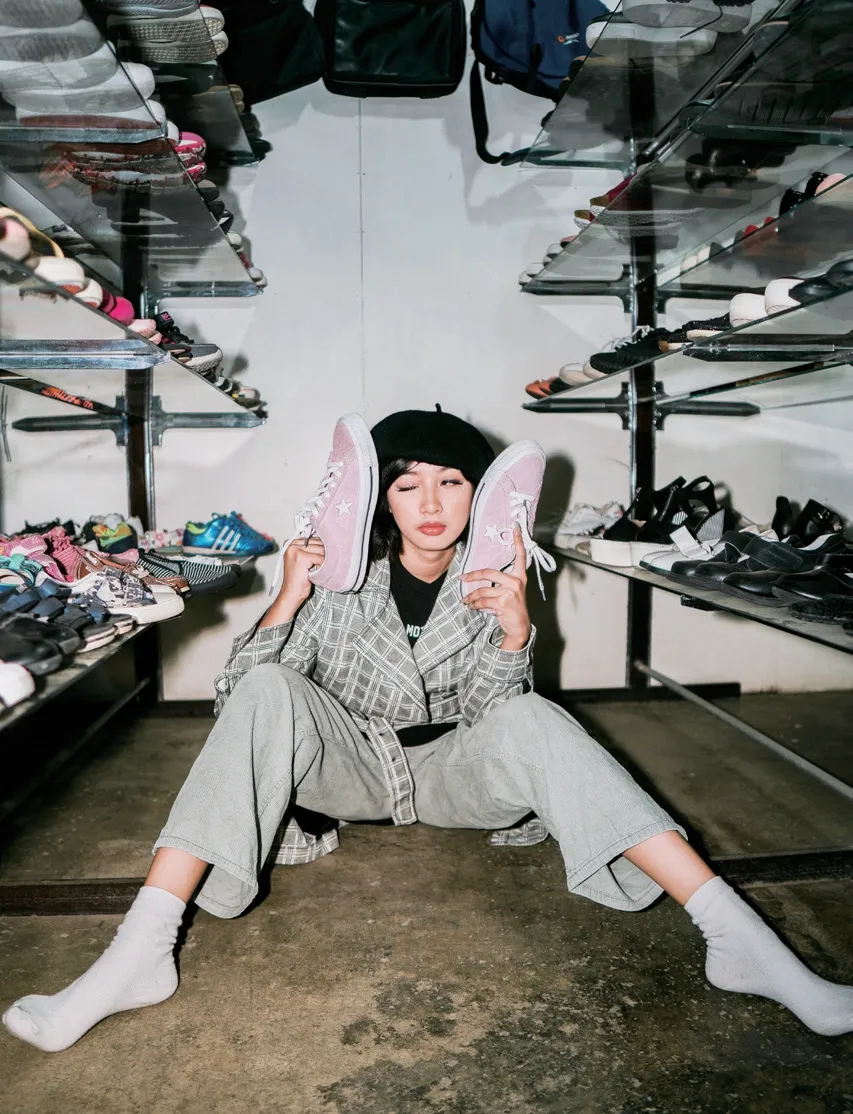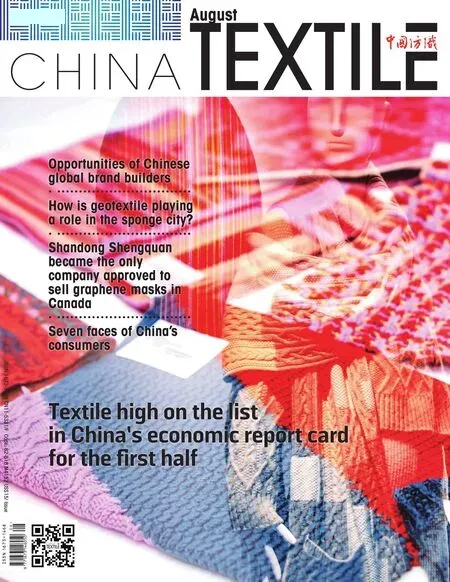2020/2021 China garment market development report

The pandemic’s suddenly coming greatly effected consuming behaviors and mindsets of consumers in 2020. As high—frequency, non—necessary goods, the market scale of garment had a certain blow inevitably.Significantly, at present, 2020—2021 China garment market development report, released by China National Commercial Information Center, stressed the pursue of people to comfortable, health and environmental friendly qualities and the development trends of digital consump—tion and sustained fashion have not changed because of the pandemic, oppositely, it performs more obviously in garment market in 2020.
Market size down but online sales growth
The report points out that in 2020, China's clothing market was greatly impacted by the COVID—19, and the retail sales of clothing products per unit above designated size was less than that of the same period in 2019, and the consumer prices of household clothing was decline.But at the same time, the pandemic has accelerated the pace of commerce embracing the digital age, and emerg—ing business forms such as live e—commerce streaming and contact—less commerce have promoted the positive growth of online retail sales of "wear" goods. With the normalization of China's pandemic prevention, the effec—tive promotion of consumption policies and household consumption has gradually returned to the development track, the garment market has shown a steady recovery and positive development trend.
The pandemic has led to a decline in the size of the clothing market. In 2020, the retail sales of restricted units of clothing products were less than the same period in 2019, and the consumer prices of clothing fell. From January to October in 2020, the retail sales of clothing products above designated size reached 664.21 billion yuan, down 11.2% compared with the same period in 2019, and the decline was 8 percentage points higher than the average decline level of the retail sales of cloth—ing products above designated size. At the same time,as consumers have more time to stay at home and fewer social occasions, their requirements for the grade of clothing have been reduced accordingly, and the con—sumer price of clothing has dropped accordingly.
The clothing retail sales of major large — scale retail enterprises, mainly department stores, declined signifi—cantly. The sales decline of department stores was sig—nificantly higher than that of other physical retail formats.In the first three quarters of 2020, the retail sales of de—partment stores among retail units above designated size decreased by 16.6% year on year, which was 7.4 and 9.8 percentage points higher than that of specialized stores and specialty stores, respectively, making them the most affected retail business. From January to October in 2020,retail sales of major national retail enterprises, mainly department stores, declined by 18.4%, failing to continue the momentum of steady and positive development in 2019.
Inelastic Demand to push up clothing prices for large retail enterprises. Due to the fact that the shopping malls failed to carry out the Spring Festival promotion activities in 2020, clothing brands mostly took online discounts to deal with the inventory goods. Therefore, during the pan—demic period, most consumers who could still buy clothes in physical stores were due to the necessary consumer demand for new clothes. As a result, the average price of clothing consumption in large retail enterprises rose sig—nificantly from 2019. In the first 10 months of 2020, the unit price of clothing transaction in key large—scale retail enterprises increased by 17.5%, but the retail volume of clothing decreased by 37.3%.
Clothing consumption concentrates on the head brand. On the one hand, in recent years, in order to in—crease the service format, large retail enterprises, which mainly focus on the department store, will appropriately streamline the clothing brand stores. On the other hand,under the circumstance of greater uncertainty, the con—sumer psychology of the mainstream customers of department stores tends to be cautious and rational,and they are more inclined to buy head clothing brands.Therefore, in the first 10 months of 2020, the market concentration of the top 10 clothing brands is generally higher than before. Online clothing category of retail sales to achieve positive growth, but sales growth slowed. In the first 10 months of 2020, with the total retail sales of consumer goods dropping by 5.9%, online retail sales of physical goods reached 7.5619 billion yuan, up 16%year on year, showing a rapid growth against the trend.The high growth rate has greatly boosted the proportion of online consumption, with online retail sales of physical goods accounting for 24.2% of the consumer market, up 3.5 percentage points from 2019. In the first 10 months of 2020, online retail sales of clothing grew by 5.6 per—cent, 9.8 percentage points slower than in 2019.
Compensatory consumption promotes the clothing market recovery rapidly. Statistics show that the retail sales of clothing units above the quota began to achieve continuous positive growth since August in 2020, and the growth rate continues to accelerate. Clothing sales at large retailers returned to positive growth in October same year.
Live shopping is continuously surging
China's e—commerce has entered a new stage of de—velopment "from flat—dimensional to three—dimensional,from image to scene, from commodity sales to value creation". The rise of "stay—at—home economy" has pro—moted live streaming platforms such as Taobao, Douyin and Kuaishou to become hot channels in the new stage of e—commerce development.
New free tax policy has push the luxury market in—creased a lot. In 2020, china’s a series of free tax policy injected some energy and confidence for some stagnant markets. Benefited from oversea consume backflow and free tax policy, China’s luxury industry can be said in its best time and stage. No matter stores on mainland China and duty free shops or high—end department stores in Beijing, Shanghai, Guangzhou and some developed re—gions, the sales performance of luxury brands achieved a pretty considerable increase.
The pandemic has changed the way people lived in the past and created demands for more sports at home.Residents have more time to think about how to make their life at home better, healthier and comfortable. This change on consumer psychology has given birth to new market opportunities for subdivided categories such as sportswear, home wear and underwear.

The market for sustainable fashion continues to heat up. The pandemic has increased people's aware—ness of environmental protection, and green has become a popular color worldwide. Sustainable fashion is not just a business, but a balancing act between consumerism and environmentalism. Clothing consumption presents the characteristics of diversified development from pos—session to rent, from trend to retro, from pursuit of craft design to return to nature and sustainability.
Brand clothing consumption is concentrated in cen—tral cities. In 2020, the consumption of brand clothing will be concentrated in central cities, and the gap between the growth rate of clothing consumption of key large—scale retail enterprises in first—class cities and that of second—class and third—class cities will increase significantly.
Consumption expectations stabiliz e
Garment consumption growth rate will improve significantly. Although the pandemic has not yet ended,China has formed a scientific and effective prevention and control mechanism, and some progress has been made in medical treatment. People's lives have basically returned to normal. People's expectations of future income growth have begun to improve, and there will be more policies to promote consumption under the new pattern of double—cycle development. All these factors are conducive to the recovery of the apparel market to the pre—pandemic level,and may also promote the sustained and rapid growth of apparel categories such as sports apparel and home ap—parel.
There will be more emerging consume modes. The pandemic didn’t change the development trend of the market, oppositely, accelerate the pace of commercial innovation. Consumers' acceptance of online retail chan—nels has increased significantly compared with the time before pandemic, digital transformation of physical retail—ers is in the ascendant, and new consumer innovations such as live streaming shopping, online experience and sharing economy are in full swing. Driven by the innova—tion demands of the country, enterprises and consumers,more new consumption patterns will emerge in the cloth—ing market.
The clothing market will pay more attention to aes—thetic equality. Consumers pay more attention to inner beauty and mindset peace, and people's demand for clothing is balanced in many ways. New fabrics, new de—signs, new techniques to achieve the aesthetic equality of clothing. The market emerges more styles and trends like universal size, all—match style, natural style, neutra clothing brands, and gradually become a new fashion industry.
Clothing brands will transfer their own special values.No matter luxury brands, fast fashion brands or street brands, brands who got through this crisis smoothly even bucked the trend, all had clear and characteristic values and aims. Under the highly uncertain market environ—ment, clothing enterprises should provide consumer who they are and what they insist on for the long time.
The clothing brand will highlight the symbolism of lifestyle. The relationship between clothing brands and consumers will no longer be "looking down" or "looking up", but to find the balance point of their own values from the other side, so as to achieve the coexistence and co—prosperity of business and art. There will be more clothing brands that connect with specific consumer groups by exploring the lifestyle, and transmit this symbolic mean—ing into the mass.
- China Textile的其它文章
- Spandex price survey: demand greater than supply
- Supply and demand of yarn market forecast in the second half of year
- As price goes up and down, how the fabric enterprises survive?
- Dye production decreased but is expected to pick up
- Prosperity index of the national textile and apparel specialized market declined overall
- Foreign trade trend in the second half of the year

